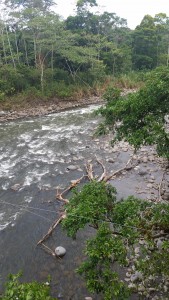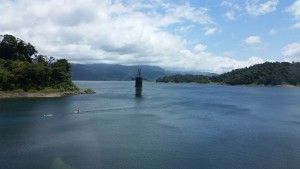In my previous blog posts, I have discussed and thoroughly described weekly nature outings in Texas that tied back to my reoccurring theme which largely consisted of floods in Texas. For this blog post I will be discussing my experiences in Costa Rica as well as comparing and contrasting these outings with the experiences in Texas.
It is important to discuss important features that these distinct environments have in order to better understand the different occurrences of rainwater that each region receives. Costa Rica is located in Central America relatively close to the equator which plays an important role in the climate that the country has. The country experiences a subtropical and tropical climate which brings along a rainy and dry season. The dry season usually expands from December to April and the rainy season begins in May and ends in November. During the rainy season, the country usually receives around 100 inches of rain although some mountainous regions receive up to 25 feet of rain. Another important factor to consider would be the amount of sunlight that the country receives which is around 12 hours of sunlight year around. The sun rises and sets at the same hours throughout the year. These factors play an important role in the biodiversity of plants and animals found in Costa Rica.
Unlike Costa Rica, Texas is not close to the equator and does not possess any tropical characteristics however it does have a variety of regions that have different features. For the majority of my nature outings in Texas explored the central, coastal and northern regions. The coastal region experiences large amounts of humidity and is largely affected by its proximity to the Gulf of Mexico. Coastal region receives 40-60 inches of rainfall a year. The northern region which is composed of prairies and lakes primarily because it is the transitional point between the Panhandle in the West and the Pineywoods in the East. The northern region receives around 26-40 inches of rain. The central region or also known as the Hill Country is mostly grassland that lies in the Edwards Plateau which has been exposed to erosion for many years now and has shaped it into today’s terrain. This area receives approximately 15-34 inches of rain per year.
Not only do these distinct regions of the world have different environments they also have unique societal characteristics that play a significant part on the environment. Observing my natural surroundings in nature back home I realized that I saw an incredible amount of pollution. I did not have to walk a great distance on a trail to come across with some type of trash. Pollution in Costa Rica was not as prominent as it was in Texas, it was rare to see trash on the floor whether it be in a city or out in nature. I believe that this difference in environmental conservation between the two societies has a lot to do with education. Traveling across Costa Rica I noticed several schools that emphasized environmental education lots of them had signs that strictly mentioned environmental science as a focus. Costa Rica believes that environmental education is essential to facilitate the progress of sustainable development in the country. Texas, however, does not have any schools, especially elementary schools teaching environmental science as a central focus point. Another striking observation was the inclusion of recycling and compost bins even the smallest villages had up to 5 different bins. Children in Costa Rica at a young age begin to understand to separate the different objects at a young age they become aware of the potential carbon footprint that they can have on the world. Conversing with Llafes, a young boy who lived on the finca where we helped build a greenhouse, I realized that children in Costa Rica have a sense of their natural surroundings. Llafes was able to converse with me in regards to his favorite plants, how he helped and the reasons and importance of planting. Unfortunately, I was unable to ask him how old he was I concluded he was around 7-8 years old. No matter how smart 8-year-olds maybe in the U.S you hardly find one that can talk about plants and know so much about its natural surroundings.

The picture above was taken from a hanging bridge that crosses a river running through the Tirimbina.
The government also plays an important role in facilitating environmental conservation. The government knows the importance of maintaining nature intact to protect its biodiversity and for the economic support that it can receive. Ecotourism seems to be flourishing within the country bringing in lots of money and it is also used as an incentive to promote conservation. After going zip lining through the rainforest I realized how important conserving the rainforest means to this industry. I personally would not like to zip line through a deforested region. Its biodiversity of plants and animals is what attracts people who ultimately bring in the money. Conserving the rainforest is crucial for Costa Rica’s energy sector which largely depends on hydroelectricity. Hydroelectricity constitutes more than 75 percent of Costa Rica’s electricity.n its rainforests and it is in the governments best interest to protect and conserve its rainforests.
Costa Rica and Texas are two regions that seem to have nothing in common: the climate, people, culture, and government seem to be completely different the only thing they have in common is nature.
As I began to compare and contrast research and observations that I had gathered throughout various months including the trip to Costa Rica I realized how the two distinct regions experienced unusual rainfalls. Referring back to my previous blog post in which I discussed the large amounts of rainfall that the city of Houston received including the consequences and damages that it had. I noticed that the average rainfall that the city of Houston receives is around 40-60 inches of rain per year. This year the city of Houston received approximately 20 inches of rain in just a 24 hour period that is approximately half the amount of rainfall it was supposed to receive throughout the course of a year. The natural phenomenon had not been seen in years.
I also realized how Costa Rica was supposed to be experiencing its rainy season however, I heard multiple guides talk about how it had been really dry lately and the country had not received much rainfall. I found this surprising especially for a country that receives around 100 inches of rain in a year. A large portion of Costa Rica is composed of rainforest and a tropical climate so it was really interesting to hear how dry the country has recently been. Before the departure to Costa Rica, I remember people advising us to be prepared for rain I was disappointed to see that we barely experienced any rain. I also couldn’t help but notice the low water level of the Arenal lake which is built from a dam used to generate electricity. At that point, I realized how vulnerable Costa Rica’s energy sector can be when the country does not receive rainfall which may or may not be directly linked to climate change. I found it interesting to see that just a year ago Costa Rica was receiving an abundance of rainfall that allowed the country to have all of its electricity come from renewable sources for 285 days.

The picture above is Lake Arenal if you pay close attention you are able to tell where the water once reached the shore and see the low water level.
I came across information that showed the consequences of an abundance of rainfall in Costa Rica. Flooding in Cost Rica is not anything new in June of 2015 it experienced heavy rainfall, flooding began to severely affect communities many people lost their houses classes across the country were canceled and a total of 216 communities were directly affected by the flooding. I concluded that the effects that flooding can have seem to be the same across homes are lost and communities are affected.
Tico Time
Being able to have the opportunity to visit Costa Rica has been a life changing experience. The trip really brought me back to nature made me feel part of its system which many seem to forget we are part of. The amount of knowledge that I gained in one week is incredible. The feeling that comes about from being surrounded by such a large biodiversity and realizing you are part of the Earths lungs is a feeling that can not be described in words. All the animal life seemed to come together to play a melodious song. It was interesting to see how all these animals are directly interconnected and realizing that you were part of this interconnected web made you feel at home. Every aspect of Costa Rica taught me something that made me grow as a person. I consider Costa Rica a Light Green Republic simply by the fact that I would like for every country to strive to be a Green Republic. Not one person, thing, or country is perfect there will always be room to improve.
When the last tree has been cut down, the last fish caught, the last river poisoned, only then will we realize that one cannot eat money. -Cree Indian
Solo despues que el ultimo arbol sea cortado, solo despues que el ultimo rio haya sido envenenado, solo despues que el ultimo pez haya sido atrapado, solo entonces nos daremos cuenta que no nos podemos comer el dinero. – Indios Cree
Bibliography
“Costa Rica Weather Has Two Distinct Seasons – High Season and Green Season.” Go Visit Costa Rica. N.p., n.d. Web. 24 May 2016.
Blum, N., Environmental education in Costa Rica: Building a framework for sustainable development? International Journal of Educational Development (2007), doi:10.1016/j.ijedudev.2007.05.008
“COSTA RICA.” Anuario De Estudios Centroamericanos No. 1 (2011): n. pag. Renewable Energy Observatory.Web.
“Costa Rican Capital Hit by Heavy Rains, Flash Floods.” The Tico Times. N.p., 28 Oct. 2015. Web. 24 May 2016.
Dyer, Zach. “Hundreds Left Homeless by Costa Rica Flooding -.” The Tico Times. N.p., 29 June 2015. Web. 24 May 2016.
Fieldstadt, Elisha. “‘Unprecedented’: 5 Dead as Record Rainfall Floods Houston.” NBC News. N.p., 18 Apr. 2016. Web. 24 May 2016.
“Geography of Costa Rica.” About.com Education. N.p., n.d. Web. 24 May 2016.
Mellino, Cole. “Costa Rica Powers 285 Days of 2015 With 100% Renewable Energy.” EcoWatch. N.p., 24 Dec. 2015. Web.
“TPWD Kids: Texas Hill Country.” TPWD Kids: Texas Hill Country. N.p., n.d. Web. 24 May 2016.
“The World Factbook: Costa Rica.” Central Intelligence Agency. Central Intelligence Agency, 25 Feb. 2016. Web. 24 May 2016.